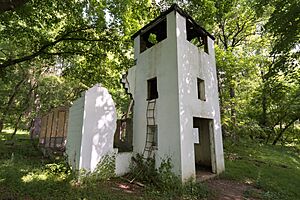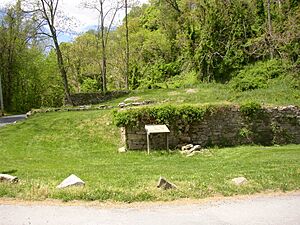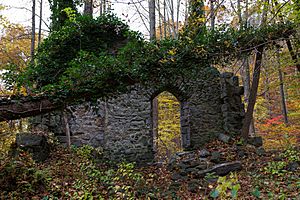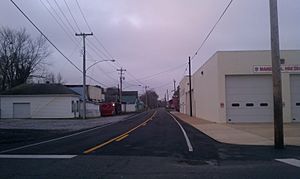List of ghost towns in Maryland facts for kids

Have you ever wondered about towns that used to be busy and full of life, but are now mostly empty or completely gone? These are called ghost towns. In Maryland, you can find many places that were once thriving communities but are now just memories.
Ghost towns can look very different. Some might have a few old buildings still standing, while others have completely disappeared, turning back into fields or forests. Sometimes, a few people might still live in a "ghost town," but it's much smaller than it was in its past.
Many of Maryland's ghost towns are found in the Appalachian region, especially in Garrett County. In the 1700s and 1800s, many towns grew quickly because of busy industries like coal mining, railroads, and making iron. But as the natural resources ran out and the Great Depression hit in the late 1920s, many of these industrial towns slowly faded away.
What Makes a Ghost Town?

Ghost towns are often grouped by how much of them is left. Here are some ways to think about them:
Completely Gone Sites
These are places where almost nothing is left.
- The town might have been destroyed.
- It could be covered by water, like a lake created by a dam.
- The land might have turned back into fields or forests.
- You might only find a few old foundations or small clues that a town was once there.
Mostly Ruined Sites

At these sites, you can still see some parts of the old town.
- There might be piles of rubble.
- All the buildings are empty and nobody lives in them.
- Some buildings might still have walls, but no roofs.
Abandoned Sites
These towns still have buildings standing, but they are empty.
- Houses and other buildings are still there.
- All the buildings are abandoned, meaning no one lives or works in them.
- There are no residents, except maybe a caretaker looking after the property.
- Sometimes, only one or two buildings, like an old church or store, are left from the original town.
Partially Abandoned Sites
These are towns where some people still live, but many buildings are empty.
- Buildings and houses are still standing.
- Many buildings are abandoned.
- Only a few people live there compared to how many used to.
- The town is much smaller than it was during its busiest times.

Historic Communities
These are towns that are still active, but much smaller than they used to be.
- Buildings and houses are still standing.
- It's still a busy community, but not as busy as it once was.
- The number of people living there has dropped a lot, sometimes to one-fifth or less of its original size.
Maryland's Ghost Towns by County
Baltimore City
- Old Town Mall: A shopping area in Baltimore that is mostly empty now.
- Wagner's Point: An industrial area where all the people had to move out in the late 1990s because of environmental concerns.
Baltimore County
- Daniels (also partly in Howard County): An old town that used to have mills along the Patapsco River.
- Relay: Once a busy railroad town, it became very small. Today, only a few people live there, and its old landmarks are gone.
- Warren: This town was flooded when the Loch Raven Reservoir was created.
Calvert County
- Calverton: The first main town of Calvert County, now completely gone.
- Wilson: This town appeared on maps until about 1901.
Cecil County
- Conowingo: The original town was flooded when the Conowingo Reservoir was built. The people moved to a new spot nearby.
- Frenchtown: This town was once a busy place for steam boat travel. It became less important when the Chesapeake and Delaware Canal opened, and then even less so with railroads.
- United States Naval Training Center Bainbridge: A naval training base that operated from 1942 to 1976.
Charles County
- Port Tobacco Village: This was once the second largest town in Maryland. By 2010, it had become the smallest town in Maryland.
Frederick County
- Harmony Grove: An old milling town that was abandoned in the early 1900s. Many of its buildings were torn down in the 1960s and 1970s for a highway.
- Monocacy: Thought to be the oldest settlement in Western Maryland. The site of Monocacy was completely lost after it was abandoned in the early 1800s and has never been found again.
Garrett County
- Altamont
- Bloomington
- Blooming Rose: First settled in 1791.
- Davis
- Dodson
- Floyd
- Frankville: Known for the death of Francis Thomas in 1876.
- Gleason
- Gorman
- Kempton: A coal mining town on the border of West Virginia.
- Kendall: An old town where people used to cut down trees for wood.
- Schell (partly in Mineral County, West Virginia)
- Selbysport
- Shallmar
- Skipnish
- Thomas
- Vindex
- Wallman
- Wilson (partly in Grant County, West Virginia)
Harford County
Howard County
- Daniels (also partly in Baltimore County)
Prince George's County
Queen Anne's County
Somerset County
- Marion Station
- Tulls Corner: A community near Marion Station that is almost gone.
St. Mary's County
- St. Mary's City: This was once an important colonial town. Now, it's a historic area run by the state and home to St. Mary's College of Maryland.
Washington County
- Fort Ritchie: A former military base that closed in 1998. The last people living there moved out in 2017.
- Four Locks: Found in the Chesapeake and Ohio Canal National Historical Park.
- Weverton: While there is a town called Weverton today, it's not in the same spot as the original one.
Worcester County
See also
- List of counties in Maryland
- Category:Mining in Maryland
- Baltimore and Annapolis Railroad

